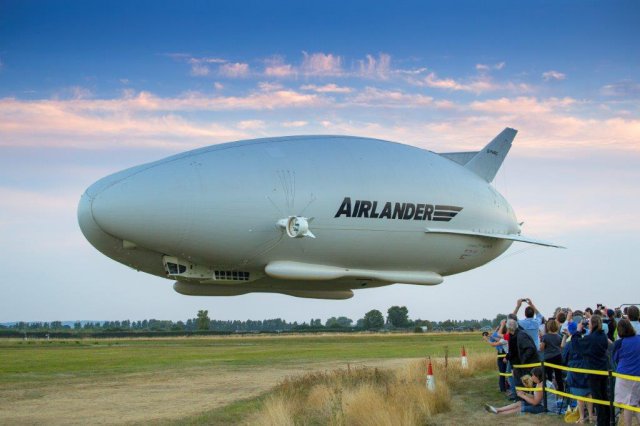 Airlander 10 took off from the historic Cardington Airfield in Bedfordshire, England at approximately 19:45 on Wednesday 17th of August, after a short flight it landed at 20:00, before dark.
Airlander 10 took off from the historic Cardington Airfield in Bedfordshire, England at approximately 19:45 on Wednesday 17th of August, after a short flight it landed at 20:00, before dark.
Chief Test Pilot Dave Burns said, “It was privilege to fly the Airlander for the first time and it flew wonderfully. I’m really excited about getting it airborne. It flew like a dream.”
A confirmatory Pre-flight test began at 0900 this morning and once Technical Director Mike Durham, Chief Test Pilot David Burns and Ground Operations Chief Alex Travell were all in agreement, clearance was granted for First Flight to commence. These three have been working together for almost thirty years, which illustrates the depth of experience and know- how within Hybrid Air Vehicles.
The four massive but quiet engines were started approximately 30 minutes before takeoff. Once airborne, Chief Test Pilot David Burns, accompanied by Test Pilot Simon Davies, flew the majestic Airlander within a 6 mile (5 nautical mile) area around Cardington Airfield, just to the south of Bedford, in England. Airlander climbed to a height of 500ft and reached a maximum speed of 35 knots. Due to a later than anticipated take-off time the Airlander was limited to a 19 minute flight so we could land safely before darkness fell.
All test objectives were met during the flight. These included the safe launch, flight and landing of the Airlander 10 and a series of gentle turns at increasing speed. Some technical tests on its hull pressure were also undertaken.
The Airlander 10 was originally designed as part of Northrop Grumman’s ill-fated long-endurance multi-intelligence vehicle (LEMV) program for the U.S. Army. Although the LEMV program was cancelled, HAV was able to re-acquire the prototype, and is now re-positioning it as a civilian-centric platform.
However, in light of numerous prospective military customers expressing interest in the Airlander 10’s viability as an ISR platform, Leonardo is configuring an appropriate sensor, electro-optical as well as electronic warfare (EW) and electronics countermeasures (ECM) suite for the aircraft.
The HAV Airlander 10 has a maximum speed of 80 kt (148 km/h), altitude of 6096 metres (i.e. 20,000 ft), endurance of five days (manned) and 21 days (unmanned), and maximum payload of 3172 kg (Aviation Week).
Comment and Analysis
Leonardo got involved with the HAV Airlander 10 program in December 2014, when it had signed an agreement with Hybrid Air Vehicles to develop an ISR suite for the platform (Aviation International News). Given Leonardo’s existing radar, electro-optical (EO) and EW/ECM catalogue, it should not be long before the company unveils its configuration for the Airlander 10. At the minimum, one could expect an ISR suite for low anti-air warfare (AAW) threat environments, such as counterinsurgency (COIN) conflict zones.
There will be a measure of skepticism against the Airlander 10, especially from those circles that do not see the value of a slow-moving aircraft. While slow, the Airlander does possess a longer endurance period, i.e. days (in comparison to hours for most existing ISR platforms). Endurance will be the Airlander 10’s – as well as other airships’ – principal advantage over alternative ISR methods.
In a low-intensity conflict zone, such as that of COIN, states are not fighting against sparsely positioned and fast-moving insurgents, but also against mounting operational costs and time. The latter serves as an indirect cost in that a country marred in internal conflict could be impacted by indirect economic costs, such as a loss of economic activity within the conflict zone, or a loss of foreign investment as a result of outside investors perceive as an unsafe and unstable climate.
To put it simply, costs can mount quickly, and heavily. For example, it is very costly to operate a fighter aircraft, not just in terms of direct costs (e.g. fuel), but also the long-term cost of a gradually worn airframe and follow-on maintenance. Unmanned aerial vehicles (UAV) have emerged as popular supplementary ISR solutions, but the limited payload of most UAV systems (and in many cases range and endurance) will once again limit their viability in a long-term low-intensity conflict environment.
Cue the Airlander 10. The Airlander 10’s large size and long-endurance capabilities can enable air forces to deploy powerful ISR suites for days at a time. As long as the AAW threat is limited or non-existent (which is the case in most current-day COIN deployments), the Airlander 10 could freely loiter over an area whilst providing valuable synthetic aperture radar (SAR) imagery (of moving targets on the ground) or infrared video coverage at night. It could also potentially serve as an airborne command post to manage ground and aerial assets engaged in the combat area.
It will be interesting to see if Leonardo attempts to position the Airlander 10 for external defence needs – i.e. conflicts against opposing armed forces. If equipped with a powerful radar suite, the Airlander 10 could potentially operate as a stand-off range (i.e. away from AAW threats) ISR system. While it is not possible to overcome the airship’s inherent design limitations in terms of speed and maneouvrability, the aircraft could be outfitted with a powerful EW/ECM suite for jamming, which could provide a layer of protection against incoming radar-guided air-to-air missiles.
Sources: Press Release / Quwa

Do not forget another attribute of lighter than air vehicles, whether free flying or tethered (Aerostats). They do not present a threat to neighboring countries. Fighter aircraft or even armed drones can threaten other countries, and even inadvertent intrusions create tension and incidents. Slow moving blimps, or aerostats that break away from their mooringspresent no threat.